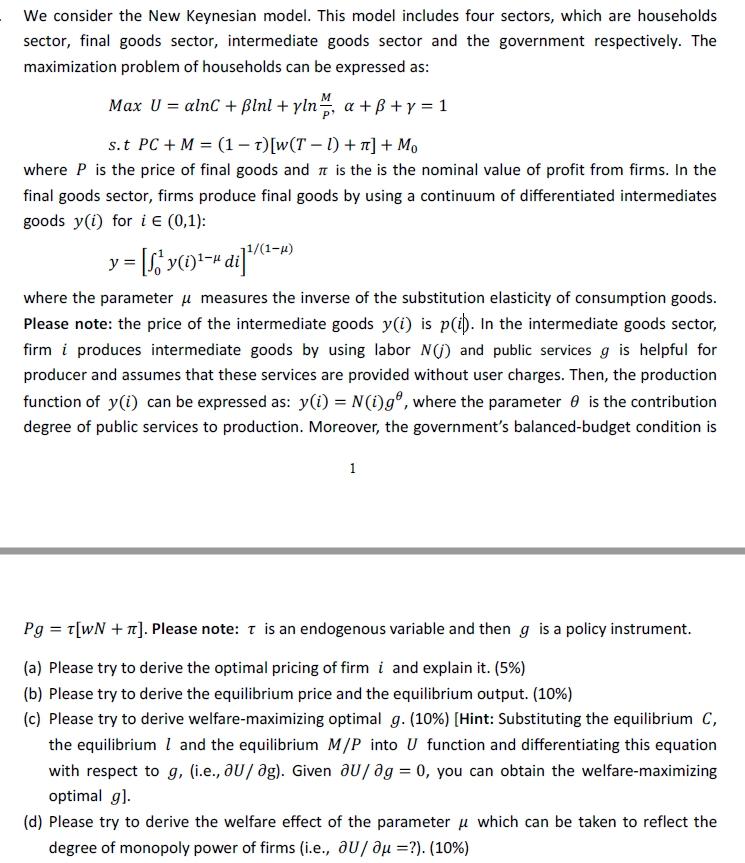Home /
Expert Answers /
Economics /
we-consider-the-new-keynesian-model-this-model-includes-four-sectors-which-pa182
(Solved): We consider the New Keynesian model. This model includes four sectors, which ...

We consider the New Keynesian model. This model includes four sectors, which are households sector, final goods sector, intermediate goods sector and the government respectively. The maximization problem of households can be expressed as: \[ \begin{array}{l} \operatorname{Max} U=\alpha \ln C+\beta \ln l+\gamma \ln \frac{M}{P}, \alpha+\beta+\gamma=1 \\ \text { s.t } P C+M=(1-\tau)[w(T-l)+\pi]+M_{0} \end{array} \] where \( P \) is the price of final goods and \( \pi \) is the is the nominal value of profit from firms. In the final goods sector, firms produce final goods by using a continuum of differentiated intermediates goods \( y(i) \) for \( i \in(0,1) \) \[ y=\left[\int_{0}^{1} y(i)^{1-\mu} d i\right]^{1 /(1-\mu)} \] where the parameter \( \mu \) measures the inverse of the substitution elasticity of consumption goods. Please note: the price of the intermediate goods \( y(i) \) is \( p(i) \). In the intermediate goods sector, firm \( i \) produces intermediate goods by using labor \( N(j) \) and public services \( g \) is helpful for producer and assumes that these services are provided without user charges. Then, the production function of \( y(i) \) can be expressed as: \( y(i)=N(i) g^{\theta} \), where the parameter \( \theta \) is the contribution degree of public services to production. Moreover, the government's balanced-budget condition is 1 \( P g=\tau[w N+\pi] \). Please note: \( \tau \) is an endogenous variable and then \( g \) is a policy instrument. (a) Please try to derive the optimal pricing of firm \( i \) and explain it. (5\%) (b) Please try to derive the equilibrium price and the equilibrium output. (10\%) (c) Please try to derive welfare-maximizing optimal \( g \). (10\%) [Hint: Substituting the equilibrium \( C \), the equilibrium \( l \) and the equilibrium \( M / P \) into \( U \) function and differentiating this equation with respect to \( g \), (i.e., \( \partial U / \partial \mathrm{g} \) ). Given \( \partial U / \partial g=0 \), you can obtain the welfare-maximizing optimal \( g \) ]. (d) Please try to derive the welfare effect of the parameter \( \mu \) which can be taken to reflect the degree of monopoly power of firms (i.e., \( \partial U / \partial \mu= \) ?). (10\%)
Expert Answer
a) The optimal pricing of firm i is determined by the profit maximization condition, which is given by: [\frac{\partial}{\partial p(i)} [p(i)y(i) - wN